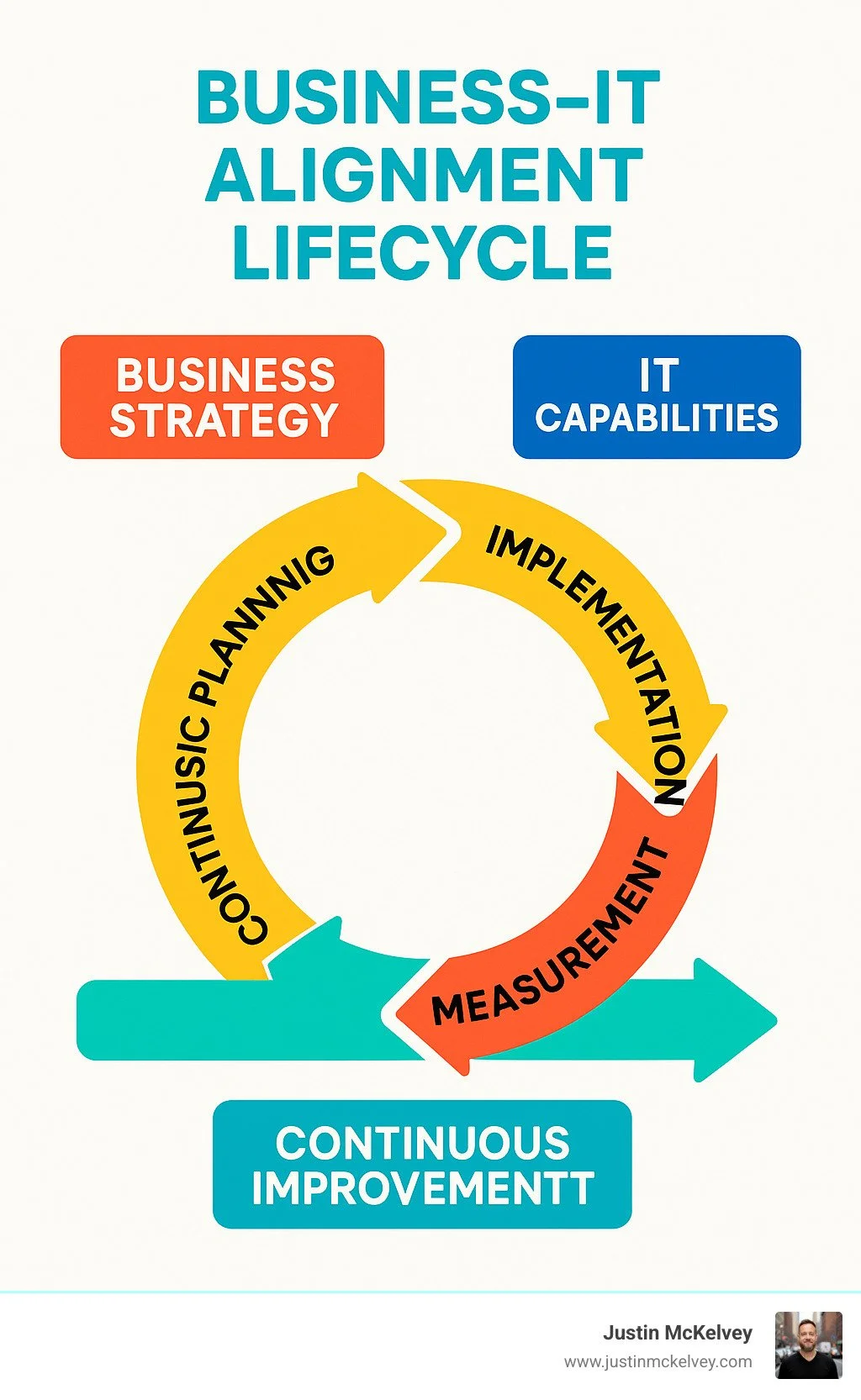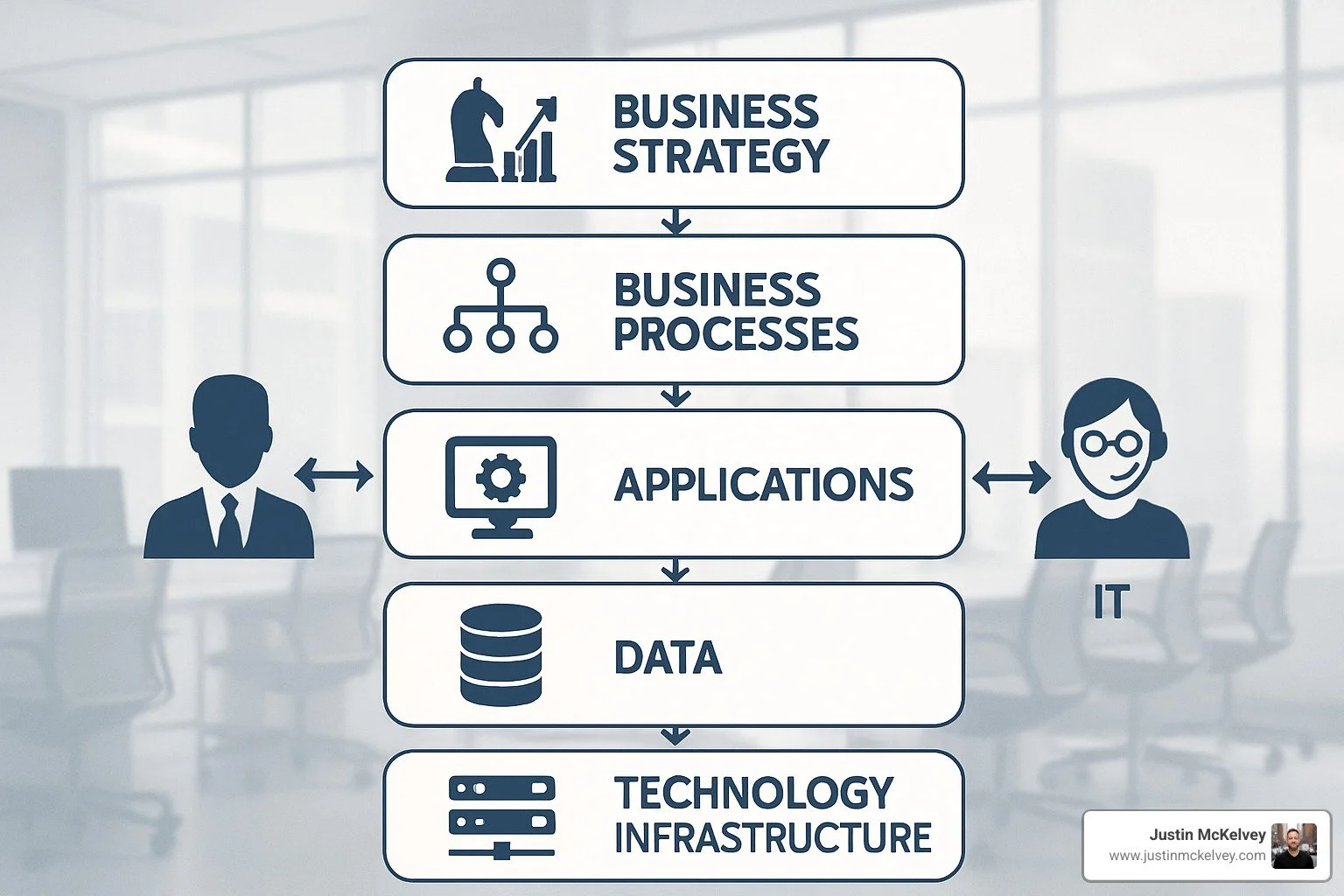Aligning Stars and Servers – What is Alignment Between Business and Information Technology?
What Business-IT Alignment Really Means
Ever walked into a room where everyone's speaking different languages? That's what happens in companies when business and IT teams aren't aligned. So let's get clear on what we're talking about here.
What is alignment between business and information technology? At its heart, it's about getting your company's business goals and your tech systems to dance to the same music. It means your technology investments directly support what your business is trying to achieve—not just existing in a separate tech bubble.
Think of it as a partnership rather than a service relationship. When your marketing team dreams up a new campaign, your IT folks should already understand how they can make it technically possible. When your IT team finds a new solution, your business leaders should immediately see how it creates competitive advantage.
True alignment shows up in several key ways:
Strategic fit happens when every technology decision clearly supports your business strategy. No more tech for tech's sake!
Value creation means your IT projects deliver real, measurable business outcomes that executives can see and appreciate.
Open communication creates ongoing dialogue between business and IT leadership, with each side truly understanding the other's world.
Shared governance establishes collaborative decision-making about technology investments, with both sides having meaningful input.
Cultural integration breaks down those frustrating silos between technical and business teams, creating one unified organization.
I've seen how companies transform when they get this right. It's not just a technical consideration—it's a fundamental business imperative in today's digital-everything world. When your systems and strategies hum along in harmony, you can pivot quickly when markets change, innovate more effectively, and create experiences that make customers smile.
The data backs this up too. Organizations with strong business-IT alignment consistently outperform their competitors in both financial results and innovation metrics. And when digital initiatives fail? The disconnect between business and IT teams is almost always among the top culprits.
The best part? This alignment isn't static—it evolves as your business does. Technology leaders participate in business strategy sessions, while business executives take genuine interest in technology capabilities. It's a continuous conversation that keeps both sides moving forward together.
Understanding What is Alignment Between Business and Information Technology
When people ask "what is alignment between business and information technology?", they're really asking about something that's both simple and profound. At its heart, business-IT alignment means getting your technology to walk hand-in-hand with what your business is trying to achieve. It's not a one-and-done project but more like a relationship that needs constant nurturing as your business evolves and technology advances.
This idea really took off in the 1990s when Henderson and Venkatraman introduced their Strategic Alignment Model (SAM). But in today's world, where technology touches literally everything we do in business, it's not just relevant—it's essential.
Think of enterprise architecture as your blueprint for this alignment—it maps what your business needs to do to the tech that makes it possible. Meanwhile, IT governance gives you the rulebook for making sure your tech investments actually support what matters to the business.
But here's what many overlook: alignment is deeply human. It's about bringing together folks who think in quarterly profits and those who think in code, and helping them find common ground. It's about bridging worlds and building understanding.
The DNA of Business Strategy and IT Strategy – Where They Meet
Business strategy and IT strategy are like cousins who grew up in different countries. They're related, but they speak different languages. Business strategy talks about market position, beating competitors, and delivering value to customers. IT strategy speaks of infrastructure, application portfolios, and digital capabilities.
The magic happens at their intersection:
When your business capabilities are clearly mapped to the technologies that support them, that's alignment. When your technology roadmaps explicitly connect to business goals, that's alignment. When investment decisions weigh both business impact and technical feasibility, that's alignment. And when your performance metrics track both business outcomes and technical performance, you're truly aligned.
In our work at Justin McKelvey, we've noticed something interesting: the most successful companies don't treat IT as "that department down the hall." Instead, they weave technology thinking into the fabric of their business planning. Their tech leaders aren't just invited to strategy meetings—they're expected to contribute to discussions about new markets, product development, and customer experience.
As one of our clients so perfectly put it: "We stopped thinking about having an IT strategy. Instead, we have a business strategy with technology woven throughout." That's the sweet spot.
Classic Frameworks That Map the Terrain (SAM, COBIT, TOGAF)
Navigating business-IT alignment can feel like exploring without a map. Thankfully, several frameworks can guide your journey:
Strategic Alignment Model (SAM) breaks alignment into four domains that need to work together: business strategy, IT strategy, business operations, and IT infrastructure. It reminds us that alignment isn't just about high-level strategies—it's also about making sure day-to-day operations in both worlds support those strategies.
COBIT (Control Objectives for Information and Related Technologies) is like a governance toolkit that helps you develop, implement, and improve how you manage IT. It offers controls and metrics that connect IT initiatives back to what the business actually needs.
TOGAF (The Open Group Architecture Framework) gives you methods and tools for building and managing your enterprise architecture. Its Architecture Development Method (ADM) helps ensure your tech infrastructure and applications don't just exist—they actively support what your business is trying to achieve.
Here's the thing about these frameworks—they're not mutually exclusive. Many organizations pick and choose elements from each to create their own custom approach. The goal isn't to rigidly follow any particular framework but to use these tools to spark meaningful conversations between your business and IT leaders.
Because ultimately, what is alignment between business and information technology if not a meaningful conversation that leads to shared understanding and purpose?
Why Alignment Matters: Benefits, Competitive Advantage & Innovation
When businesses get their technology strategy right, magic happens. Strong business-IT alignment isn't just a nice-to-have—it's a powerful driver of performance that separates market leaders from the pack.
Organizations that excel at alignment don't just work better—they consistently outperform their competitors across the board. The benefits are tangible and substantial:
Companies with well-aligned business and IT strategies typically see up to 20% higher returns on their technology investments. Why? Because every dollar spent on technology directly supports a business goal that matters. There's no waste on solutions searching for problems.
Increased business agility becomes second nature when your technology capabilities are designed with flexibility in mind. In today's market, where change is the only constant, this ability to pivot quickly isn't just an advantage—it's survival.
Risk reduction happens naturally with alignment. When technology initiatives start with clear business objectives and have strong stakeholder support from day one, the chances of expensive IT project failures drop dramatically.
Your customers feel the difference too. When business and IT teams work hand-in-hand, they create seamless experiences that delight users across every touchpoint—digital or physical.
Perhaps most exciting is how alignment opens doors to entirely new revenue streams. When business leaders truly understand what technology can do, and IT leaders deeply grasp market needs, they create solutions that weren't even on the radar before.
How Business-IT Alignment Spurs Innovation Pipelines
Innovation thrives at intersections. The most groundbreaking ideas often emerge where business insight meets technological possibility—and alignment creates this fertile meeting ground.
When different perspectives regularly collide in a healthy way, magic happens. Business and IT professionals who work together develop a shared language and understanding that naturally sparks creative solutions. Problems get solved in ways neither group would have finded alone.
One SaaS client we worked with at Justin McKelvey transformed their entire product development approach by creating teams that mixed product managers and developers. The results spoke for themselves: they cut their time-to-market for new features by 40% and saw customer satisfaction scores soar.
Aligned organizations can test new ideas quickly because they've already built bridges between business concepts and technical implementation. They're not starting from scratch each time inspiration strikes.
Data becomes a goldmine when IT systems are designed with business goals in mind. The right data, collected for the right reasons, reveals opportunities that might otherwise remain hidden.
Most powerfully, true alignment helps companies see beyond just improving what exists today. They start identifying opportunities to use technology to create entirely new value propositions—completely fresh ways to serve customers and markets.
From Cost Center to Value Driver – IT's New Mandate
Remember when IT was seen as the necessary evil—the department that cost money but was just part of doing business? Those days are gone.
The evolution in how we understand what alignment between business and information technology means has been dramatic. It used to be about making sure IT efficiently supported existing business processes. Today, it's about leveraging technology to create entirely new business capabilities that weren't previously possible.
Today's most effective CIOs are business leaders first and technology leaders second. They understand market dynamics, customer needs, and competitive pressures—not just the latest tech trends. At the same time, forward-thinking business executives have developed a working understanding of technology capabilities to make truly informed strategic decisions.
The CIO's role in digital acceleration has never been more central to business success. As technology becomes embedded in every aspect of operations, the distinction between "the business" and "IT" continues to blur.
A retail CEO we worked with put it perfectly: "Technology isn't just how we run our business anymore—it's increasingly becoming what our business is."
This fundamental shift in perspective—from IT as a cost center to IT as a value driver—is perhaps the most important evolution in business-technology alignment. When technology is viewed as a strategic asset rather than a necessary expense, the entire conversation changes.
Common Challenges & How to Overcome Them
Let's face it – even when everyone agrees that business-IT alignment matters, actually making it happen can feel like trying to merge two rivers flowing in different directions. But don't worry – these challenges are normal, and better yet, they're solvable.
Common Obstacles Quick Wins Cultural Differences Cross-functional teams and job rotations Communication Silos Shared metrics and joint planning sessions Legacy Technology Incremental modernization tied to business priorities Skills Gaps Training programs and strategic hiring Change Resistance Success stories and executive sponsorship
When we work with clients at Justin McKelvey, we often find they're struggling with several predictable problems. Cultural differences sit at the top of the list – business teams speak the language of market opportunities and customer needs, while IT folks are fluent in system stability and security protocols. It's like they're having two different conversations in the same meeting!
Communication silos make everything worse. Without regular, structured ways to share information, business and IT teams drift apart like ships in the night. One healthcare client told me, "We only realized IT was building the wrong solution when they were 80% done – because nobody had talked for three months!"
Then there's the legacy technology challenge. Those outdated systems aren't just inconvenient – they can actively block your business initiatives. I've seen executives with brilliant market strategies hit the brick wall of "our current system can't do that." Talk about frustrating!
Add in skills gaps (technology changes so fast that even dedicated professionals struggle to keep up) and natural change resistance (we're all creatures of habit), and you've got a perfect storm of misalignment.
"What is Alignment Between Business and Information Technology" – The Human Factor
Here's something I've learned after years of consulting: you can have the most sophisticated alignment frameworks in the world, but if Sarah from Marketing and Dave from IT can't stand each other, your alignment efforts are doomed.
The secret ingredient in what is alignment between business and information technology isn't technology at all – it's human connection. People need to trust each other, understand each other, and genuinely want to work together.
Building these bridges doesn't happen by accident. It takes intentional effort to create shared experiences where business and IT folks work side by side on meaningful projects. One retail client rotated staff between departments for two-week "immersion experiences" – the mutual understanding this created was worth its weight in gold.
Developing a common language matters too. When a CIO can explain cloud migration in terms of business outcomes (not technical specifications), and when marketing leaders understand enough about data architecture to have realistic expectations – that's when the magic happens.
In the end, mutual respect forms the foundation of everything. Both business expertise and technical knowledge need to be valued equally in your organization's culture. As one client beautifully put it, "We stopped seeing IT as the 'computer people' and started seeing them as business partners who happen to have technical skills."
Turning Resistance Into Readiness
Nobody likes change, especially when it disrupts comfortable routines. But resistance isn't a wall – it's a doorway, if you know how to open it.
The key is to start with why. People need to understand how better alignment will make their work lives better, not just how it helps the company. When we helped a manufacturing firm improve their alignment, we made sure everyone knew how it would reduce their frustration, eliminate redundant work, and create more interesting projects.
Early wins are rocket fuel for change. Find something small but meaningful that showcases what good alignment looks like – maybe it's a joint business-IT solution to a nagging customer problem – and celebrate it like crazy. Success creates believers faster than any PowerPoint presentation ever could.
Don't forget to provide support along the way. People may need training, resources, or simply time to adjust to new ways of working. Be generous with all three.
Create safe spaces for people to address concerns without fear. In one memorable workshop, we had business and IT teams anonymously write their fears about closer collaboration on cards. Reading them aloud created breakthrough moments of empathy on both sides.
Finally, recognize contributions from people who champion alignment. Public appreciation doesn't just make individuals feel good – it signals to everyone what your organization truly values.
The human side of alignment isn't a soft, optional extra – it's the whole ballgame. Get the people part right, and the technical pieces will fall into place much more easily.
5-Step Alignment Blueprint & Measurement Toolkit
Achieving strong alignment between business and information technology doesn't happen by accident. It requires intention, structure, and commitment. Through our work with clients across industries, we've developed a practical 5-step approach that consistently delivers results. Think of it as your roadmap to bringing business and IT teams into harmony.
Step 1: Co-Create Vision & Vocabulary – "What is Alignment Between Business and Information Technology"
Every successful alignment journey begins with getting everyone on the same page. This isn't just about agreeing on technical specs – it's about creating a shared understanding of what success looks like for your specific organization.
Start by bringing business and IT leaders together for joint visioning workshops. These sessions shouldn't feel like formal meetings but rather collaborative conversations where both sides can openly share their perspectives. We've found that these discussions often reveal surprising insights – business leaders learning about technical possibilities they didn't know existed, and IT teams gaining clarity on business priorities they hadn't fully grasped.
Take time to map your stakeholders carefully. Who needs to be involved? Whose buy-in is critical? Understanding these relationships early prevents headaches later.
One of the most powerful tools we've seen is the creation of a common glossary. When a marketing exec and a systems architect both use the term "platform," do they mean the same thing? Probably not! Building this shared vocabulary breaks down communication barriers that often derail alignment efforts.
Cap this phase by creating an alignment charter – a living document that captures your goals, principles, and how decisions will be made. This becomes your north star when challenges arise.
Step 2: Map Capabilities to Goals – Value Streams First
With your shared vision established, it's time to get practical about how business and technology connect in your organization. This mapping exercise creates transparency that benefits everyone.
Start by documenting your key business capabilities – the essential activities that make your organization tick. Then take stock of your technology portfolio and honestly assess how well these tools support those capabilities. Are you investing heavily in systems that support low-priority business functions while neglecting technology that could boost your competitive edge?
Value stream analysis is where the magic happens. By mapping end-to-end processes that deliver value to customers, you can see exactly where technology touches the business – and where those touchpoints could be improved. This often reveals surprising gaps and opportunities that neither business nor IT teams would spot on their own.
One retail client finded that their substantial investment in inventory management technology wasn't addressing the real business pain point: getting products from distribution centers to stores faster. This insight completely shifted their technology roadmap.
Step 3: Govern & Fund for Flexibility – Agile Portfolios
Traditional governance models often reinforce the very silos we're trying to break down. When business and IT have separate budgets, decision-making bodies, and success metrics, alignment struggles to take root.
The solution? Create joint decision-making bodies with balanced representation from both worlds. These aren't just committees that rubber-stamp decisions – they're collaborative forums where business and technology leaders make choices together.
Value-based funding represents a fundamental shift in how organizations allocate resources. Rather than departmental budgets that create turf wars, consider funding business capabilities or customer journeys that naturally span multiple teams. This approach ensures money flows to initiatives that create the most business value, regardless of which department champions them.
Agile portfolio management practices help you stay nimble as business priorities shift. Set aside dedicated innovation funding to explore emerging technologies with business potential – these small bets can yield big returns when business and IT collaborate on them from the start.
Step 4: Measure What Matters – Balanced Scorecard, OKRs, Alignment Index
You've probably heard the saying, "What gets measured gets managed." For business-IT alignment, this couldn't be more true. The right metrics create accountability and provide early warning signals when teams begin to drift apart.
A balanced scorecard approach works wonderfully for alignment because it naturally spans multiple perspectives – financial outcomes, customer experience, internal processes, and organizational learning. This prevents the common trap of focusing solely on technical metrics that IT cares about or business metrics that don't account for technical realities.
Setting Objectives and Key Results (OKRs) that deliberately cross functional boundaries can be transformative. When a business objective requires IT enablement to succeed, and both teams share accountability for the outcome, collaboration flourishes.
Consider developing an alignment index – a composite metric that tracks overall alignment health across dimensions like strategic understanding, project delivery satisfaction, and collaborative behaviors. We've seen organizations display these metrics prominently, turning alignment from an abstract concept into something teams can rally around improving.
Most importantly, establish a regular cadence for reviewing these metrics together. These shouldn't be blame sessions when numbers dip, but honest conversations about how to strengthen the partnership.
Step 5: Iterate, Learn, Celebrate Wins
Alignment isn't a destination you reach once and check off your list – it's an ongoing journey that requires care and feeding. The organizations that excel at business-IT alignment treat it as a continuous improvement process.
Regularly step back to assess what's working and what isn't in your alignment approach. Are governance meetings productive or turning into status updates? Is your measurement system driving the right behaviors? These reflections help you refine your approach over time.
Create intentional mechanisms for sharing alignment successes across your organization. When a cross-functional team delivers exceptional results through strong collaboration, tell that story far and wide. These narratives shape your culture more powerfully than any policy document.
Recognition matters deeply. When you celebrate individuals and teams that exemplify strong business-IT partnership, you signal what your organization truly values. These don't need to be elaborate awards – sometimes a sincere acknowledgment in a company meeting carries more weight than a formal program.
Finally, don't operate in a vacuum. Benchmark your alignment maturity against industry peers and recognized best practices. This external perspective helps you identify blind spots and opportunities you might miss looking only inward.
Ready to start your alignment journey? Download our 5 Steps to Successful Business-IT Alignment guide for practical worksheets and templates to implement this blueprint in your organization.
Frequently Asked Questions about Business-IT Alignment
What KPIs best reflect strong alignment?
When clients ask me about measuring business-IT alignment, I always emphasize that the best KPIs blend business outcomes with technical performance. It's not enough to track just one side of the equation.
In our consulting work, we've found that organizations with strong alignment typically monitor a balanced set of metrics. Business Value Realization stands out as particularly powerful – tracking what percentage of your IT initiatives actually deliver their promised business benefits. It's surprising how many organizations invest in technology without circling back to verify the results!
Time-to-Market is another critical indicator. How quickly can your organization turn business needs into technology-enabled capabilities? In today's fast-moving markets, this speed often separates leaders from followers.
We also recommend tracking your Strategic Project Success Rate – are you completing the technology initiatives that directly support your most important business goals? Many organizations spread their technology resources too thinly across too many projects.
Don't overlook the human element, either. Regular Business Satisfaction surveys provide invaluable feedback on how well IT is meeting business needs from the perspective of the people who matter most – your internal customers.
Finally, look at your Joint Decision Making processes. What percentage of significant technology decisions include meaningful input from both business and IT leaders? This metric often reveals how well your governance structures are working in practice.
How often should alignment reviews occur?
Alignment isn't something you can set up once and forget about – it requires ongoing attention at different levels of your organization.
Think of business-IT alignment like tending a garden rather than building a monument. At the strategic level, conduct thorough reviews annually as part of your business planning cycle. This ensures your technology strategy evolves alongside your business strategy.
Quarterly portfolio reviews help maintain alignment at the project level. These reviews are your chance to adjust priorities and resources based on changing business needs. I've seen too many organizations stick rigidly to outdated project plans simply because they didn't build in these regular checkpoints.
For day-to-day operations, monthly monitoring of service levels and performance metrics helps catch small misalignments before they become big problems. These operational reviews are especially important for customer-facing systems where technology directly impacts the customer experience.
Most importantly, create channels for continuous feedback between business and IT teams. The organizations we work with that have the strongest alignment don't rely solely on formal reviews – they've built a culture of ongoing dialogue.
Your optimal review frequency might vary based on your industry, size, and how quickly your business environment changes. But regardless of these factors, make alignment reviews a regular habit, not an occasional exercise.
Does cloud adoption automatically improve alignment?
I often hear executives assume that moving to the cloud will automatically solve their alignment challenges. The reality is more nuanced.
Cloud technologies certainly can enable better business-IT alignment, but they don't guarantee it. The cloud's ability to increase agility is perhaps its biggest alignment benefit. When business teams need new capabilities, cloud services can often be provisioned in days rather than the months traditional infrastructure might require.
Cloud adoption also typically shifts IT's focus from managing infrastructure to delivering business value – a welcome change that can strengthen alignment. Plus, modern cloud platforms provide access to advanced capabilities like AI, analytics, and automation that can drive business innovation.
However, I've seen plenty of organizations where cloud adoption actually worsened alignment by enabling "shadow IT" – business units implementing technology solutions without proper coordination with IT. Without good governance, the ease of cloud adoption can lead to fragmentation, security risks, and increased costs.
The key isn't the technology itself but how you govern and manage it. At Justin McKelvey, we help clients implement cloud governance frameworks that maintain alignment while leveraging the cloud's benefits. The goal is finding the right balance between flexibility and control.
Technology choices – cloud or otherwise – should always start with business needs, not the other way around. When cloud adoption flows from a clear understanding of business requirements, it becomes a powerful enabler of alignment rather than just another technology trend.
Conclusion
The journey toward strong alignment between business and information technology is both challenging and rewarding. Organizations that excel at this alignment gain significant competitive advantages through increased agility, innovation, and efficiency.
As we've explored throughout this article, alignment isn't just about technology—it's about people working together with shared purpose. It's about breaking down those traditional walls between business and IT teams that have existed for far too long in many organizations.
Think of the 5-step blueprint we've outlined as your roadmap, but every organization charts its own unique course. The most important thing is to start the conversation, establish those shared goals, and commit to getting better over time. This isn't a "set it and forget it" situation—it's an ongoing relationship that needs nurturing.
Here at Justin McKelvey, we've guided countless organizations through this journey. Our technology consulting approach is refreshingly straightforward—we help simplify complex technology issues and create practical solutions that actually align with what your business is trying to achieve. We firmly believe that technology should serve your business goals, not become another problem to manage.
I like to remind clients that alignment isn't a destination you reach and then check off your list. It's more like tending a garden—requiring consistent attention as both your business needs evolve and technology capabilities advance. The organizations that thrive will be those that view business-IT alignment not as a project with an end date, but as a capability they continuously strengthen.
When you invest in better alignment today, you're not just solving an immediate problem—you're positioning your organization for success in an increasingly digital future. Yes, the stars and servers really can align—and when they do, the results can transform your entire business.
Want to talk about how we can help you improve the connection between your business strategy and technology capabilities? Learn more about our technology consulting services and let's start a conversation about your unique alignment challenges.





